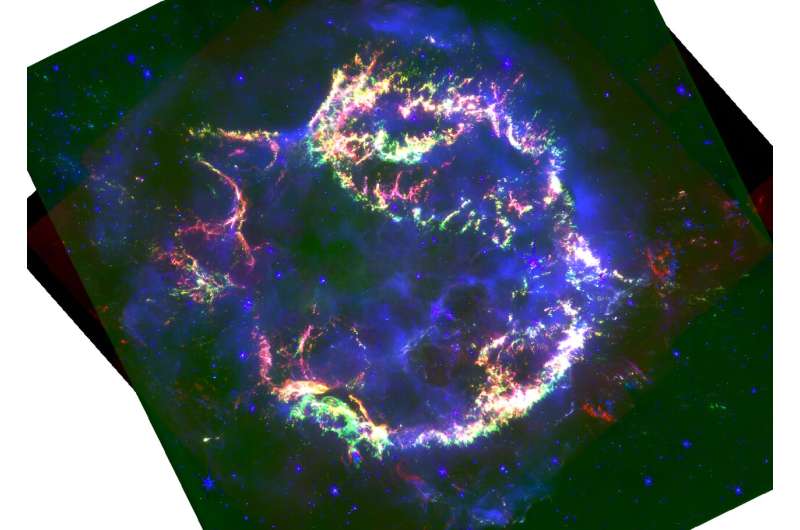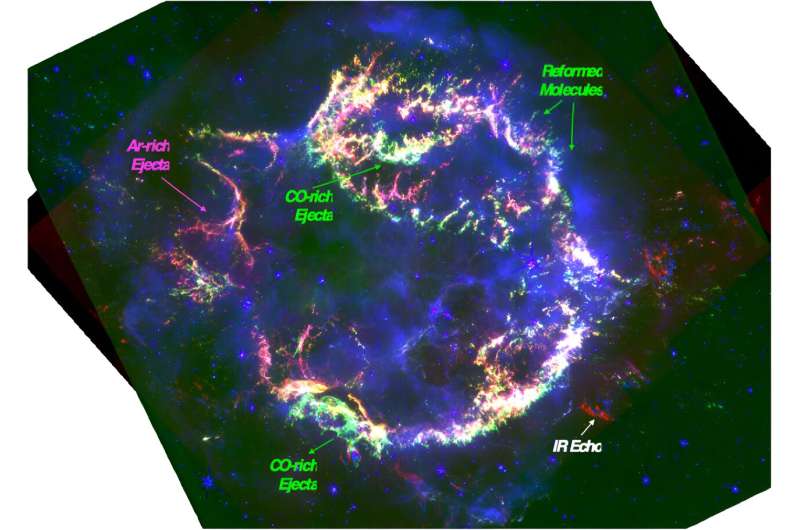
Trichromatic images of Cassiopeia A taken by JWST, with contrast between the carbon monoxide (CO in green) and argon (red) ejections and the synchrotron emission (blue). The images show that there is more CO gas in the outer layers than argon gas, meaning that the CO molecules are reforming after the reverse collision. Credit: SETI Institute
The SETI Institute announced the latest findings from the James Webb Space Telescope (JWST) on the supernova remnant Cassiopeia A (Cas A). These observations of the youngest known core-collapse supernova in the Milky Way provide insight into the conditions that lead to the formation and destruction of molecules and dust in supernova ejections.
The study results change our understanding of dust formation in the early universe in galaxies detected by JWST 300 million years after the Big Bang. The researchers consider supernovae, such as those that formed Cas A, to be vital sources of the dust observed in distant galaxies at high redshift. This new knowledge challenges beliefs that the dust came primarily from intermediate-mass stars of the asymptotic giant branch (AGB) in present-day galaxies.
“It is remarkable how bright the carbon monoxide emission detected by JWST NIR imaging and spectroscopy is, showing a few dozen sinusoidal patterns of fundamental CO rovibrational lines,” said Dr. Jeohghee Rho, a research scientist at the SETI Institute who led the research. “The patterns appear to have been artificially generated.”
The main conclusions are as follows:
- Molecular formation of CO: The data show that the outer layers contain more CO gas than argon gas, meaning that CO molecules reform after the reverse shock. This data is important for understanding how cooling and dust formation occurs after a supernova explosion. The images indicate that CO molecules reform behind the shock and may have shielded the dust in the ejecta.
- Detailed spectroscopy: NIRSpec-IFU spectra of two important areas of Cas A show differences in how the elements were formed. Both regions have strong CO gas signals and show various ionized elements like argon, silicon, calcium and magnesium. The fundamental CO lines are a few dozen sinusoidal patterns of fundamental CO rovibrational lines with a continuum below due to the high velocity of the CO molecules.
- Temperature information: Research shows that the temperature is around 1080 K, based on CO gas emissions. This helps us understand how dust, molecules and highly ionized gas interact in supernovae. However, the authors also find vibrational lines in the high rotation lines (J=90), whose features appear between 4.3 and 4.4 microns. These lines indicate the presence of a hotter temperature component (4800 K), implying the formation and reformation of CO at the same time. CO from such high rotation levels is observed for the first time in Cas A with the new JWST spectroscopy.
- Supernovae like Cas A, located 11,000 light-years away, are explosions that occur when a high-mass star reaches the end of its life about 350 years ago. Called a core-collapse supernova, the star’s interior collapses inward under gravity once the nuclear fuel that powered the star is exhausted. The rebound from this collapse propels the star’s outer shell into space in an explosion that can eclipse an entire galaxy.

Credit: SETI Institute
“Seeing such hot CO in a young supernova remnant is truly remarkable and indicates that CO formation is still occurring thousands of years after the explosion,” said Chris Ashall, assistant professor at Virginia Tech.
“Combining these impressive data sets with previous observations of supernovae from JWST will allow us to understand the pathways to the formation of molecules and dust in a way that was not possible before.”
Revolutionary imaging and spectroscopy
The observations were made using JWST’s Near-Infrared Camera (NIRCam) and Mid-Infrared Instrument (MIRI) instruments, as well as detailed Near-Infrared Spectrograph (NIRSpec)-Integral Field Units (IFU) spectroscopy. The team mapped the complex structures of synchrotron radiation (light emitted when charged particles, such as electrons, are accelerated to high speeds in strong magnetic fields), argon-rich ejections, and carbon monoxide (CO) molecules in Cas A. The images show highly detailed and complex patterns of shells, holes, and filaments, highlighting the power of JWST.

Credit: SETI Institute
Seong Hyun Park, a graduate student at Seoul National University in South Korea, carried out the modeling of CO properties in collaboration with Rho.
The new observations highlight the complex and competing processes of molecular formation and destruction in supernova remnants. Although they do not directly lead to dust formation, CO molecules are key indicators of the cooling and chemical processes that ultimately lead to dust condensation.
While this study offers new insights, debate continues over the extent to which supernovae contribute to dust formation in the early universe. Researchers will continue to explore these phenomena with future observations and research to unravel the mysteries of cosmic dust and molecular formation.
The results are published this week in Letters from the Astrophysical Journal.
More information:
J. Rho et al., Molecular features of incredibly bright hot carbon monoxide in the Cassiopeia A supernova remnant revealed by JWST, Letters from the Astrophysical Journal (2024). DOI: 10.3847/2041-8213/ad5186
Provided by the SETI Institute
Quote:Webb unveils stunning ejecta and CO structures in young supernova Cassiopeia A (2024, July 15) retrieved July 15, 2024 from https://phys.org/news/2024-07-webb-unveils-stunning-ejecta-cassiopeia.html
This document is subject to copyright. Apart from any fair dealing for the purpose of private study or research, no part may be reproduced without written permission. The content is provided for informational purposes only.